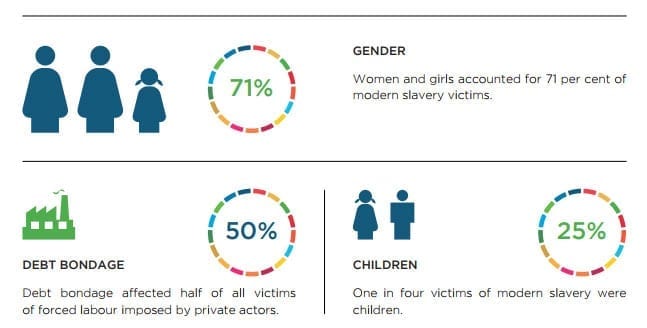
Sep 20, 2017
Some 25 million people toiled in forced labor around the world in 2016, and 18 percent were children, according to two new reports by the International Labor Organization (ILO) and the Walk Free Foundation.
“Global Estimates of Child Labor” and “Global Estimates of Modern Slavery” estimate that overall, 40.3 million people are victims of “modern slavery,” which the report describes as including forced labor and forced marriage.
Far more women and girls experience forced labor, making up 58 percent—9.2 million—of the 16 million in forced labor in the private economy. Some 50 percent of women and men in forced labor also were in debt bondage, in which personal debt is used to forcibly obtain labor. This proportion rises above 70 percent for adults forced to work in agriculture, domestic work or manufacturing.
While forced labor occurs all around the world, it is most prevalent in Asia and the Pacific, where the proportion of those trapped in forced labor is four per a population of 1,000. The European and Central Asian region has the second highest proportion, with 3.6 people in forced labor per 1,000, followed by Africa (2.8), the Arab States (2.2) and the Americas (1.3).
152 Million Children Involved in Child Labor
According to the ILO report, children make up 18 percent of victims of forced labor exploitation, 7 percent of those in state-enforced forced labor, and 21 percent of victims of commercial sexual exploitation. Overall, the reports estimate that there are 152 million children involved in child labor globally, with 73 million of them in hazardous work that is dangerous to their health and safety. This overall figure represents a decline from 2012, part of a larger trend in lowering the amount of children involved in labor in the 21st century. However, this decline has slowed dramatically in recent years.
Many experts suggest the reports’ estimates could understate the extent of forced labor. Fiona David, executive director of Global Research at Walk Free told the Washington Post the estimate could be conservative because of the challenges of doing research in conflict areas like Syria or Nigeria.
The ILO reports include strategies for ending forced labor that center on achieving the United Nation’s 2030 Agenda and include studying root causes of modern slavery like debt bondage, and developing policies that specifically address the gender imbalances of modern slavery.
In combatting child labor, Solidarity Center works with the Global March Against Child Labor, a worldwide network dedicated to eradicating the practice, and is a member of the multi-member Child Labor Coalition.
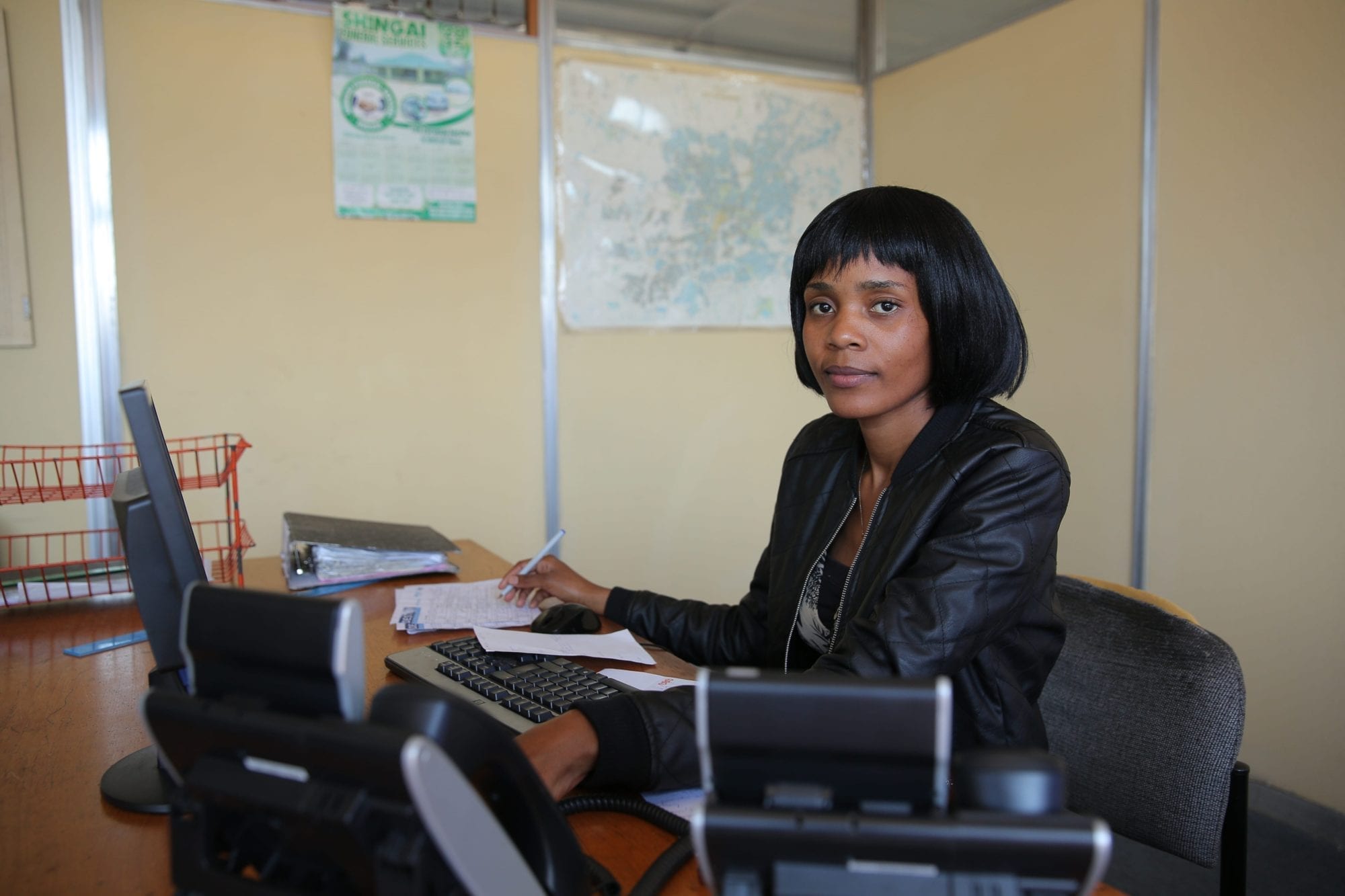
Dec 20, 2016
Workers around the world are losing ground in their paychecks as annual growth in real wages around the world fell to 1.7 percent in 2015, down from 2.5 percent in 2012, according to a new International Labor Organization (ILO) report.
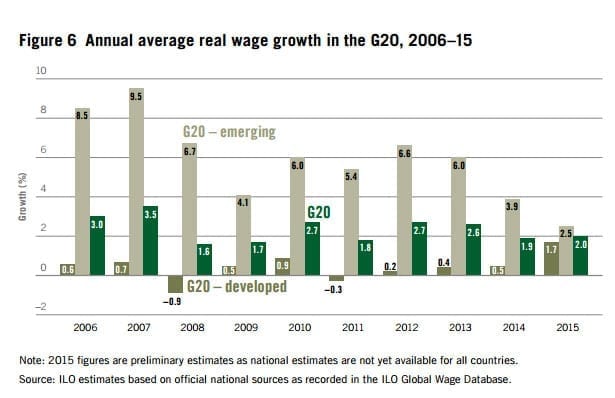
Credit: ILO
Wages have stagnated primarily in developing and emerging economies, especially in Latin America and Eastern Europe, according to the Global Wage Report 2016/17.
Among developing countries—including China, India, Brazil, Nigeria and many other rapidly growing economies—real wage growth in 2012 was around 6.6 percent, but by 2015 it had fallen to just 2.5 percent. Growth in developing countries had fueled economic recovery after the 2008 recession.
Meanwhile, wages in developed countries rose between 2012 and 2015—from 0.2 percent in the wake of the financial crisis, to a 10-year high of 1.7 percent. This uptick does not compensate for slowing wage growth in developing countries, yielding a net decrease worldwide.
To create sustainable wage growth, the ILO calls on countries to enact policy reforms that will benefit working people, such as raising minimum wages and increasing workers’ access to collective bargaining, particularly in global supply chains. The ILO also calls for coordination at the global level to boost wages, reduce inequality and protect working people’s right to freedom of association.
Productivity Outpaces Wages, Workers Miss Out
In the majority of countries, “wage growth in recent decades has lagged behind the growth of labor productivity,” according to the report. This means that even as major economic sectors like agriculture and construction have become more prosperous, workers are getting a smaller and smaller share of that prosperity.
The ILO attributes this divide to the weakening of labor market institutions and pressure from financial markets to direct company profits toward investors rather than workers. As a result, the ILO report says stagnating wages in developing countries are part of a slow but steady decline in working people’s share of wealth in the global economy.
Women have been especially hard hit, earning between 10 percent and 40 percent less than men in hourly wages in many countries. In Azerbaijan and Benin, the gender gap was the highest at nearly 45 percent. Many women work in low-paid, precarious jobs and although they contribute 66 percent of the world’s work, they earn 10 percent of income.
Crucially, the report highlights the frequent correlation between greater wage inequality, greater household income inequality and the declining number of jobs.
Read the full report.
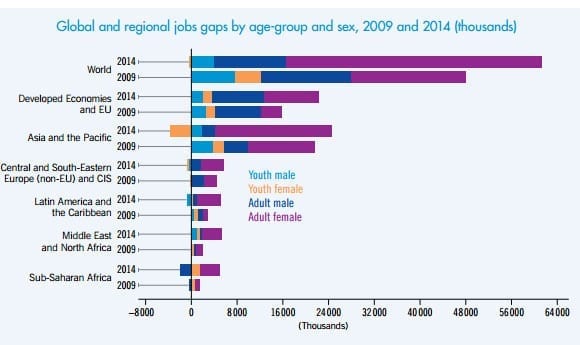
May 19, 2015
More than 60 percent of workers worldwide, predominantly women, are in temporary, part-time or short-term jobs in which wages are falling, a growing trend that is fueling global income inequality and poverty, according to an International Labor Organization (ILO) report released today.
“This report reveals a shift away from the standard employment model, in which workers earn wages and salaries in a dependent employment relationship vis-à-vis their employers, have stable jobs and work full time,” the report states. Further, “labor incomes constitute the main source of income inequality.”
Although the incomes of permanent workers are relatively stable, the percentage of such workers is declining globally—and as few as 20 percent of workers are in permanent jobs in regions such as sub-Saharan Africa and South Asia. Many of these precarious jobs are in the informal economy, which includes market vendors, day laborers, pedicab drivers and domestic workers. In fact, domestic workers, most of whom are women, represent 3.6 percent of wage employment worldwide, the report says.
“World Employment and Social Outlook: The Changing Nature of Jobs” cites a shortage in global aggregate demand as a potentially key factor in explaining the slow growth of decent jobs, which has created a global jobs gap that costs an estimated $1.218 trillion in lost wages for workers around the world. The ILO estimates that 201 million women and men were out of work in 2014, more than 30 million higher than before the start of the 2008 global economic crisis.
“A vicious circle may be at work, with lower demand affecting output and employment, thereby further depressing demand,” the report states. In other words, fewer jobs and lower wages mean workers and their families will be able to purchase less, and so fewer jobs will be created and low-pay will be the norm, a vicious cycle that can only be broken by large-scale job creation and incomes that sustain working people and their families.
Workers making low pay are less likely to be union members or to benefit from collective bargaining, according to the report. Further, despite widespread unemployment, in particular among women, there is very limited social protection for unemployed working-age adults. The report recommends policy changes that address the transformation in employment structures and include the growing numbers of precarious workers in social protection systems.
The report also notes that approximately 1 in 5 workers contribute to global supply chains, which “facilitates transitions to the formal economy and waged employment for many workers.” However, the study equally highlights that the vast majority of employment in the global supply chain takes place under poor working conditions. This is particularly the case for vulnerable workers, such as unskilled women, youth and migrant workers.
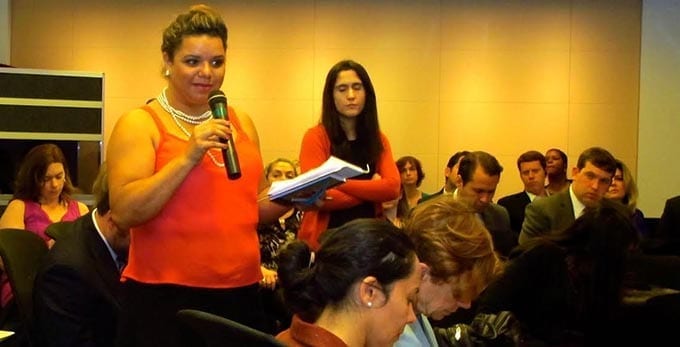
Apr 27, 2015
Mércia Silva, director of Brazil’s InPacto, an organization focused on eradicating forced labor in businesses and their supply chains, often must meet with owners and managers of companies where forced labor exists. But she doesn’t approach them “with theory,” she says.
“I take a photograph of a worker working under extremely difficult conditions and I ask them, ‘Would you like someone in your family to work like this?’ ‘Of course not,’ they say, and from there we are able to make change.”
Silva shared her strategies for empowering workers last week on the panel, “Raising the Floor—Fresh Thinking to Improve Working Conditions and Workers’ Rights,” a discussion on worker-driven strategies to improve conditions for workers enduring the most abusive conditions. The panel was part of a two-day, two-city International Labor Organization (ILO) conference, Out of the Shadows: Innovative Approaches to Combating Forced Labor and Other Forms of Worker Exploitation.
“The presence of forced labor in society doesn’t happen in a vacuum,” said Solidarity Center Executive Director Shawna Bader-Blau. “Forced labor is created by policy. And change comes from the demands and voices of workers and their unions standing up for their rights, standing up for better treatment.” Bader-Blau facilitated the panel, whose primarily U.S.-based participants discussed a range of strategies—including enlisting consumers and the global labor movement—to assist workers in winning their rights on the job.
“You can’t organize anyone with a vague vision,” said Saket Soni, executive director of the National Guestworker Alliance. “These are people who have been staring into the face of evil (forced labor). The alternative has to be concrete. For us, that alternative is, ‘what if you could sit down and negotiate a contract with your employer?’ The only way you can do that is to collectively organize.”
Silva praised Brazil’s Central Union of Workers (Central Unica dos Trabalhadores, CUT) and other Brazil union federations for seeking to make worker rights a reality for agricultural laborers toiling under what she described as “horrible working conditions.
“It’s important to open the door to unions” for these workers, she said. The Solidarity Center works with CUT and other Brazil union federations to help empower vulnerable workers. The AFL-CIO and the CUT have a several decade-long partnership to promote fundamental labor rights in the United States, Brazil and across the Americas.
Women make up a large percentage of workers in forced labor, and panel participants pointed to their key role in taking the lead to improve their working conditions. Neidi Dominguez, director of the AFL-CIO Worker Centers and Community Engagement, discussed how even though Los Angeles carwash workers are predominantly male, women workers were among those who stood up and demanded to be paid a regular wage. Until they did, carwash workers were paid on through pooled customer tips.
The conference, held in in Washington, D.C., on April 22 and in Los Angeles on April 24, brought together representatives from civil society, government and business to discuss strategies to prevent and mitigate exploitative labor practices, with a focus on the United States and Brazil. These strategies aim to decrease workers’ vulnerability to forced labor and other forms of worker exploitation.
“Raising the Floor” panelists also included Steve Hitov, general counsel for the Coalition of Immokalee Workers; and Haeyoung Yoon, deputy program director at the National Employment Law Project.
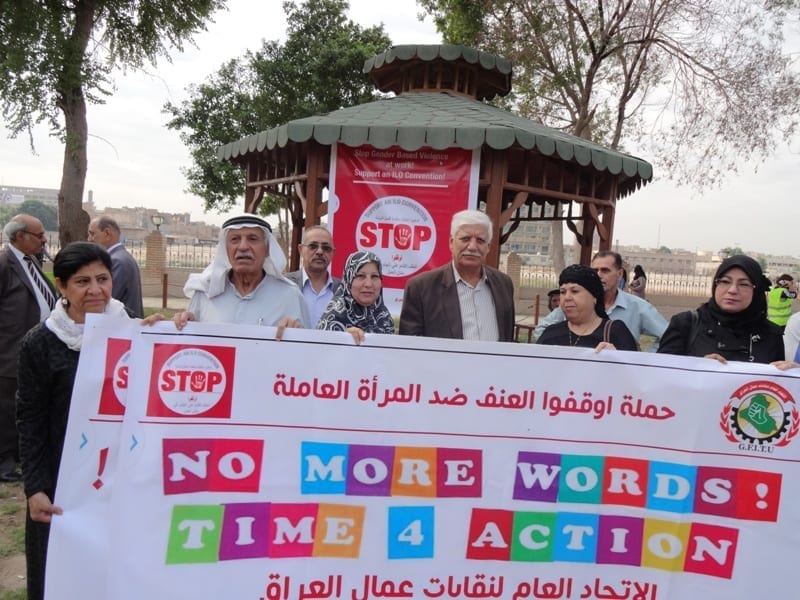
Nov 25, 2014
Violence against women takes many forms, and can happen in the home, in public spaces—and on the job. At the workplace, 35 percent of women worldwide have experienced violence.
This November 25, International Day for the Elimination of Violence against Women, unions around the world are calling for the International Labor Organization (ILO) to pass an global convention on gender-based violence at the workplace. As the International Trade Union Confederation (ITUC) points out, “anyone can be a victim of violence at work, but gender-based violence typifies unequal economic and social power relations between women and men.”
Union leaders and allies are re-submitting a proposal to the ILO Governing Body requiring the ILO to develop an international standard to guide governments and businesses in formulating strong laws and policies to prevent and remedy gender-based violence at work. The ILO Governing Body adjourned this month without considering a similar proposal, and will meet again in March 2015. (You can take action through the International Transport Workers’ Federation’s “End workplace violence against women” campaign.)
This fall, workers in the Middle East and North Africa waged rallies and sit-ins to highlight the issue. The General Federation of Iraq Trade Unions (GFITU) organized a solidarity gathering in late October at Al Qushla Square in Baghdad. Hashmeyya Al Sa’adawi,IndustriALL executive board member and president of the electricity union in Basrah, read the statement of the Arab unionist women network, which expressed concern over increased violence against women.
“We believe that the violence against women issue is a crucial matter that requires immediate action,” she stated
In Morocco, the Democratic Labor Confederation (Confédération Démocratique du Travaille, CDT), organized a sit-in outside Parliament to raise awareness about gender-based violence in the workplace and request support for the convention (watch a video clip of the event).
The Jordanian Federation of the Independent Trade Unions sent a letter to the country’s chambers of commerce and industry and Jordanian government officials urging their support for passage of the gender-based violence standards in the ILO Administration Council.
Women disproportionately work in precarious, low-income and informal economy jobs, where there are few mechanisms to prevent violence and exploitation. Women also are the majority in occupations where workers are more likely to be exposed to violence, such as domestic work and health care, the garment and textile industries and in agriculture. Many women do not report physical, psychological or sexual violence fearing they will be fired or because of cultural norms.
An ILO Convention would further acknowledge that violence against women is a human rights violation, and would be an important step to improving women’s working conditions worldwide and saving the millions of dollars spent every year on health care, lower productivity and sick leave because of violence against women,






